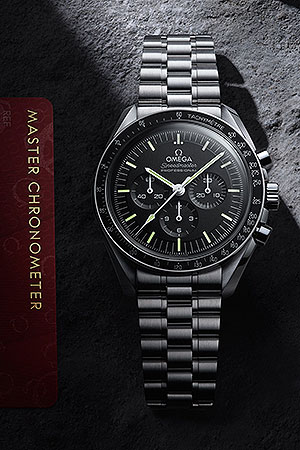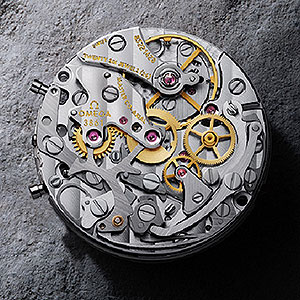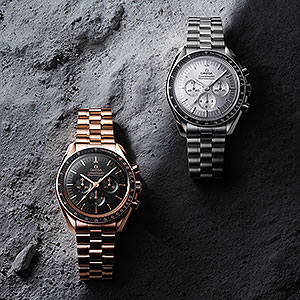Omega debuts next generation of NASA-qualified Speedmaster moonwatches

A new generation of the first watch worn on the moon carries on its iconic Apollo-era look while introducing the highest level of precision offered by a modern Swiss-made chronograph.
Omega debuted its new collection of Speedmaster Moonwatch Professional timepieces on Tuesday (Jan. 5), highlighting its state-of-the-art internal movement while also paying tribute to its more than 50-year-old lunar legacy.
"When updating a sacred timepiece like the Speedmaster Moonwatch, every detail must be true to its original spirit. This chronograph is recognized the world over, so we've approached its design with the most sincere respect, while taking its movement to the next level," Raynald Aeschlimann, Omega's president and CEO, said in a statement.
The new Speedmaster Moonwatch Professional, which continues to be flight-qualified by NASA for use on all of its crewed missions, draws its design from the Omega chronograph worn by Apollo 11 astronauts Neil Armstrong, Buzz Aldrin and Michael Collins in 1969.
Related: Astronaut Snoopy orbits the moon on new Omega Speedmaster watch
A long time coming
"I would suspect that the longest piece of NASA equipment — since it has been doing a very good job for all these years — is really the Speedmaster," Gemini and Apollo astronaut Jim Lovell, one of only three people to date to fly to the moon twice, said in a video released by Omega.
First worn in space by Mercury astronaut Wally Schirra in 1963, the Omega Speedmaster was subsequently chosen by NASA to become its only chronograph certified for use on all of its missions since 1965.
Breaking space news, the latest updates on rocket launches, skywatching events and more!
"I was the first and only one to qualify the Omega Speedmaster for spaceflight," said former NASA engineer James Ragan. "We had a whole set of different tests that we had to perform to qualify a piece of hardware. Now it wasn't intended for watches, for sure — it was hot, cold, shake, rattle and roll and we had temperatures cycling up and down — and it passed all the testing that we did."
Ragan repeated some of the tests as Omega worked to revise the design of the Speedmaster and as NASA moved onto its later programs, including the Skylab orbital workshop and space shuttle.
"It is the only one [piece of space equipment] I can think of that has been there the whole time. It has been there forever," said Ragan.
Down to the details
The new Speedmaster Moonwatch Professional retains the asymmetrical case and three subdials that have become a trademark of the classic Apollo-worn chronograph. It also has the dot over 90 ("DON") and a dot diagonal to 70 on the anodized aluminum bezel ring, details that have grown to be iconic among the watch's fans and aficionados.
Inside, the Speemaster now has the Co-Axial Master Chronometer Calibre 3861 movement to ensure that it will keep accurate time even in the most extreme of magnetic fields. In addition, it qualifies the entire watch to be certified as a Master Chronometer — the highest standard of precision, performance and magnetic-resistance in the Swiss watch industry.
The new Speedmaster also includes a redesigned bracelet, which while similar in style to Moonwatches of the past, has a new clasp with a polished Omega logo on a satin-finished cover.
The Speedmaster Moonwatch Master Chronometer collection includes a choice of hesalite glass with an embossed Seahorse caseback on a stainless steel body for $6,300 or sapphire-crystal glass on both sides, providing a view of the Calibre 3861 movement inside, for $7,150. The new models also come in Omega Sedna gold for $34,800 and Omega Canopus gold for $45,300.
Follow collectSPACE.com on Facebook and on Twitter at @collectSPACE. Copyright 2021 collectSPACE.com. All rights reserved.

Robert Pearlman is a space historian, journalist and the founder and editor of collectSPACE.com, a daily news publication and community devoted to space history with a particular focus on how and where space exploration intersects with pop culture. Pearlman is also a contributing writer for Space.com and co-author of "Space Stations: The Art, Science, and Reality of Working in Space” published by Smithsonian Books in 2018.
In 2009, he was inducted into the U.S. Space Camp Hall of Fame in Huntsville, Alabama. In 2021, he was honored by the American Astronautical Society with the Ordway Award for Sustained Excellence in Spaceflight History. In 2023, the National Space Club Florida Committee recognized Pearlman with the Kolcum News and Communications Award for excellence in telling the space story along the Space Coast and throughout the world.



